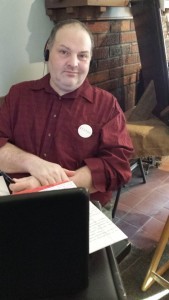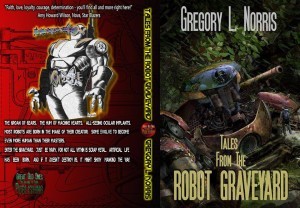Alan Baxter's Blog, page 29
December 10, 2015
Blurring The Line: Alex C Renwick
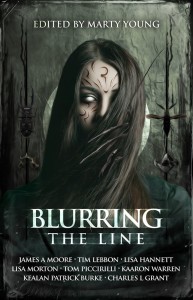 Blurring The Line is the new anthology of horror fiction and non-fiction, edited by award-winning editor Marty Young, published by Cohesion Press. You can get your copy here or anywhere you normally buy books (the print edition is coming any day now).
Blurring The Line is the new anthology of horror fiction and non-fiction, edited by award-winning editor Marty Young, published by Cohesion Press. You can get your copy here or anywhere you normally buy books (the print edition is coming any day now).
To help people learn a bit more about it, I’ve arranged for each fiction contributor to answer the same five questions, and I’ll be running these mini interviews every weekday now that the book is available.
Today, it’s:
Alex C Renwick
 Alex C. Renwick is a dual Canadian/US writer living down the street from a volcano in an Edwardian home filled with fossils, broken shells, dried willow branches, and other very pretty dead things. Her stories have appeared in Ellery Queen’s & Alfred Hitchcock’s Mystery Magazines, Machine of Death Vol. 1, and The Exile Book of New Canadian Noir. Find her at alexcrenwick.com or on Twitter @AlexCRenwick.
Alex C. Renwick is a dual Canadian/US writer living down the street from a volcano in an Edwardian home filled with fossils, broken shells, dried willow branches, and other very pretty dead things. Her stories have appeared in Ellery Queen’s & Alfred Hitchcock’s Mystery Magazines, Machine of Death Vol. 1, and The Exile Book of New Canadian Noir. Find her at alexcrenwick.com or on Twitter @AlexCRenwick.
1. What was the inspiration/motivation behind your story in Blurring The Line?
I’m intrigued by thoughts of what scares us, and more specifically, why we seek it out. If it’s true we writers write about what intrigues us, then I find the concepts of nihilism and self-destruction fascinating — why are we so drawn to that which has the power to destroy us? Anyone who’s ever experienced serious injury or disease, or chronic pain or depression or similar challenges, might recognize the internal teeter-totter my character goes through in “A Peripheral Vision Sort of Friend.” Think of Frida Kahlo’s painting “The Broken Column,” in which the artist’s torso is cracked open to expose her crumbling spine, her body held together with surgical straps and studded with popping nails as if it were a failing scaffold.
2. What does horror mean to you?
Hah! When I first noticed my work selling to self-described horror markets I went on a quest to discover what “horror” meant to anyone. I asked other writers, readers, editors, but when no clear defining characteristic emerged like it did when asking people’s thoughts on historical or science fiction, fantasy, western, crime, or even romance (all very broad genres with lots of variety), I decided it was an overlay, a flavour and approach to storytelling intended to elicit a particular sort of response rather than a distinct, much less complete, genre definition (humor falls into this category too). For me, the most horrifying stories leave one with a prevailing sense of bleakness.
3. What’s a horror short story that you think everyone should read?
This has two insanely different answers, so I guess it depends on what you’re seeking from your reading experience. My favorite dark fiction has lots of pathos, imparting an intense and overwhelming sense of loss rather than dread, like so much beautiful short fiction by Shirley Jackson or Joyce Carol Oates, or the haunting K.W. Jeter story “The First Time,” or Raymond Carver’s “Tell the Women We’re Going” and “So Much Water So Close to Home” from What We Talk About When We Talk About Love. But the stories that horrify me most I never want to read again and would be hesitant to burn into anyone else’s brain — that’s how powerful fiction can be! How traumatic! (Okay fine: “Ted’s Collection” by Claude Lalumière or “The Phone Woman” by Joe R. Lansdale.)
4. What horror novel should everyone read?
“Horror” being such an elusive and malleable concept, I’m not sure I’d know how to classify a “horror novel.” My faves that might fall into this category would be Shirley Jackson’s We Have Always Lived in the Castle and Patricia Highsmith’s The Animal-Lover’s Book of Beastly Murder — both of which are personal favorites precisely because they do not leave me with a sense of bleakness. For that I’d have to turn to something like Cormac McCarthy’s The Road. No sense of hope at the end of that one, not on my reading of it.
5. Name something that you think just might be real, or might not…
Well, living in North America’s beautiful and mysterious Pacific Northwest, I’d be practically a traitor to the region not to mention Sasquatch. But personally, I’m terrified and intrigued by what might be at the deepest crevices of our vast and undercharted oceans. I mean, we know more about the surface of Mars than we do about the ocean floor. That’s scary — and amazing!
___________________________________
Previous posts in the Blurring The Line interview series:
Marty Young
Tom Piccirilli
Lisa Morton
Tim Lebbon
Lia Swope Mitchell
Alan Baxter
James Dorr
Peter Hagelslag
Gregory L Norris
Steven Lloyd Wilson
James A Moore
.
The post Blurring The Line: Alex C Renwick appeared first on Alan Baxter - Warrior Scribe.
December 9, 2015
Blurring The Line: James A Moore
 Blurring The Line is the new anthology of horror fiction and non-fiction, edited by award-winning editor Marty Young, published by Cohesion Press. You can get your copy here or anywhere you normally buy books (the print edition is coming any day now).
Blurring The Line is the new anthology of horror fiction and non-fiction, edited by award-winning editor Marty Young, published by Cohesion Press. You can get your copy here or anywhere you normally buy books (the print edition is coming any day now).
To help people learn a bit more about it, I’ve arranged for each fiction contributor to answer the same five questions, and I’ll be running these mini interviews every weekday now that the book is available.
Today, it’s:
James A Moore
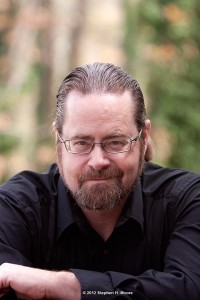 James A. Moore is the award winning author of over twenty novels, thrillers, dark fantasy and horror alike, including the critically acclaimed Fireworks, Under The Overtree, Blood Red, the Serenity Falls trilogy (featuring his recurring anti-hero, Jonathan Crowley) and his most recent novels, Blind Shdows, Homestead and the soon to be released Seven Forges. He has also recently ventured into the realm of Young Adult novels, with his new series Subject Seven. In addition to writing multiple short stories, he has also edited, with Christopher Golden and Tim Lebbon, the British Invasion anthology for Cemetery Dance Publications.
James A. Moore is the award winning author of over twenty novels, thrillers, dark fantasy and horror alike, including the critically acclaimed Fireworks, Under The Overtree, Blood Red, the Serenity Falls trilogy (featuring his recurring anti-hero, Jonathan Crowley) and his most recent novels, Blind Shdows, Homestead and the soon to be released Seven Forges. He has also recently ventured into the realm of Young Adult novels, with his new series Subject Seven. In addition to writing multiple short stories, he has also edited, with Christopher Golden and Tim Lebbon, the British Invasion anthology for Cemetery Dance Publications.
1. What was the inspiration/motivation behind your story in Blurring The Line?
I’ve lived in Louisiana, and I have absolutely no problem believing that a swamp monster could live there and never be caught on film. The bayous and swamps will likely never be properly explored.
2. What does horror mean to you?
Horror is an emotion. It’s a gripping, heart racing jolt of adrenaline in some cases and a deep and abiding sense of unease in others. I think the finest horror can get to you with the implications of a deed rather than with the deed itself.
3. What’s a horror short story that you think everyone should read?
Stephen King’s THE MONKEY. Brilliant and something that I don’t think could ever be properly translated into film because of the narrative. It’s intimate and disturbing in the best possible way.
4. What horror novel should everyone read?
That’s a list that could go on for hundreds of pages, but because you only want one, I’ll go with Christopher Golden’s SNOWBLIND. There is a pervasive sense of dread and loneliness that is delicious. Definitely a case where the chills are worthwhile.
5. Name something that you think just might be real, or might not…
Ghosts. There is a lot of evidence to say that sometimes something is left behind when a person dies and we know that energy never fades. It can merely change…
___________________________________
Previous posts in the Blurring The Line interview series:
Marty Young
Tom Piccirilli
Lisa Morton
Tim Lebbon
Lia Swope Mitchell
Alan Baxter
James Dorr
Peter Hagelslag
Gregory L Norris
Steven Lloyd Wilson
.
The post Blurring The Line: James A Moore appeared first on Alan Baxter - Warrior Scribe.
December 8, 2015
Blurring The Line: Steven Lloyd Wilson
 Blurring The Line is the new anthology of horror fiction and non-fiction, edited by award-winning editor Marty Young, published by Cohesion Press. You can get your copy here or anywhere you normally buy books (the print edition is coming any day now).
Blurring The Line is the new anthology of horror fiction and non-fiction, edited by award-winning editor Marty Young, published by Cohesion Press. You can get your copy here or anywhere you normally buy books (the print edition is coming any day now).
To help people learn a bit more about it, I’ve arranged for each fiction contributor to answer the same five questions, and I’ll be running these mini interviews every weekday now that the book is available.
Today, it’s:
Steven Lloyd Wilson
 Steven Lloyd Wilson discovered reading at a dangerously young age and writing soon thereafter. He has been writing science fiction stories since age eight when he realized that he could make Kirk and Spock do what he wanted in Word Perfect. It took fourteen years of misfires for him to finish writing his first novel, which was a magnificent disaster that should never be published. A second and third followed in short order and in 2009 he independently published Katorga, a dark yet humorous dystopian novel of a totalitarian future of brutal space colonization via gulags. He is chief film critic at Pajiba.com, where you can find his assorted non-fictions on a daily basis. In his spare time, he works as a professor of political science and is painfully close to completing his PhD in that field.
Steven Lloyd Wilson discovered reading at a dangerously young age and writing soon thereafter. He has been writing science fiction stories since age eight when he realized that he could make Kirk and Spock do what he wanted in Word Perfect. It took fourteen years of misfires for him to finish writing his first novel, which was a magnificent disaster that should never be published. A second and third followed in short order and in 2009 he independently published Katorga, a dark yet humorous dystopian novel of a totalitarian future of brutal space colonization via gulags. He is chief film critic at Pajiba.com, where you can find his assorted non-fictions on a daily basis. In his spare time, he works as a professor of political science and is painfully close to completing his PhD in that field.
1. What was the inspiration/motivation behind your story in Blurring The Line?
I’ve had stirring down in the depths of my mind this idea of a Lovecraftian story set at the South Pole during a white out ever since, well, I read several of Lovecraft’s novels on a trip to Alaska. I know, Lovecraft himself has several such stories, there’s The Thing, and a dozen others. So, real original, but I had this feeling about it. And then there was that XKCD strip (https://xkcd.com/1235/) pointing out that sightings of UFOs and other such phenomena have plummetted since the ubiquity of cell phone cameras. But what if shining the light into the darkness doesn’t show that nothing was ever there, but simply that the room is empty when you’re looking.
2. What does horror mean to you?
Horror to me as always been about the fear of the unknown. It’s about the darkness that lurks beyond the flickering fire, and what our imaginations invent as reasons for the unexplainable terrors that lurk there. It’s a primal thing, an appeal to the reptile brain, enhanced by all the creativity of the mammal brain. Science tells us how the world works, but horror tickles the back of our brain, questioning whether we really have any control or understanding in the least.
3. What’s a horror short story that you think everyone should read?
“I Have No Mouth and I Must Scream” by Harlan Ellison.
4. What horror novel should everyone read?
The Terror by Dan Simmons. Not exactly traditional horror, but that’s what makes it defy all expectation so that you can’t get an angle on why you’re uneasy, so the discomfort and fear builds and builds.
5. Name something that you think just might be real, or might not…
Hope.
___________________________________
Previous posts in the Blurring The Line interview series:
Marty Young
Tom Piccirilli
Lisa Morton
Tim Lebbon
Lia Swope Mitchell
Alan Baxter
James Dorr
Peter Hagelslag
Gregory L Norris
.
The post Blurring The Line: Steven Lloyd Wilson appeared first on Alan Baxter - Warrior Scribe.
December 7, 2015
Blurring The Line: Gregory L Norris
 Blurring The Line is the new anthology of horror fiction and non-fiction, edited by award-winning editor Marty Young, published by Cohesion Press. You can get your copy here or anywhere you normally buy books (the print edition is coming any day now).
Blurring The Line is the new anthology of horror fiction and non-fiction, edited by award-winning editor Marty Young, published by Cohesion Press. You can get your copy here or anywhere you normally buy books (the print edition is coming any day now).
To help people learn a bit more about it, I’ve arranged for each fiction contributor to answer the same five questions, and I’ll be running these mini interviews every weekday now that the book is available.
Today, it’s:
Gregory L Norris
1. What was the inspiration/motivation behind your story in Blurring The Line?
A few years ago, my sister’s car went in for repairs and my partner Bruce and I took her to work, several miles down the road from our old apartment. She worked the third shift in a rural part of our town. It was winter. Out there, the highway cut through long swathes of pine forest. The turn off to her job was defined by a traffic light that seemed to have a mind and will of its own. It would stay red on us even though we were the only car on the road. We dropped her off at work for the better part of a week. On the last night, after the insufferable wait for the light to turn red, we made the turn, traveled up the hill to her job, only to slam on the brakes as the largest buck deer I’ve ever seen clomped across the pavement in front of us, eyeing us with contempt and snorting loudly through its nostrils. It was such a haunting, unforgettable encounter, I knew it had to be written out as a short story, which I did. “1-2-3 Red Light” is the result.
2. What does horror mean to you?
I grew up on a healthy diet of creature double-features and classic SF/Horror TV, the dreamy gothic daytime soap opera Dark Shadows a staple among them. I love the elegance of a quietly creepy moment attained by reading an author’s words, suggesting the cause of the shiver teasing the nape of the reader’s neck. And I also appreciate the unapologetic spatter of a well-written, gory scene when it’s done properly. When the writing is crisp and the delivery effective, Horror can be a beautiful thing.
3. What’s a horror short story that you think everyone should read?
I recently reread “The Murders in the Rue Morgue” by Poe to prep for an appearance on a show to discuss the short story. Stunning writing, truly — and as much a work of horror as the defined beginning of the first modern detective story. A classic and an experience!
4. What horror novel should everyone read?
This past summer, I read and devoured Roxanne Dent’s novel, The Janus Demon (from Great Old Ones Publishing). It’s the tale of a gumshoe named Mick Grimaldi caught up in a complex series of crimes perpetrated by underworld figures from a supernatural realm. Roxanne is, to me, one of the finest writers around, and her novel kept me captivated. For days after finishing the novel, I struggled to find anything as good to read among my unread books, and in fact picked hers up again and read it for a second time cover to cover.
5. Name something that you think just might be real, or might not…
I was recently asked to write a real-life ghost story for a publisher, and was forced to decline because all of my ghost stories have come from my imagination, not real life. When I was a teenager living in a small New Hampshire town, I saw an object in the sky skimming just over the tops of the tall pines and to this day wonder of the truth behind that one or two second fragment of time, which haunts me to this day decades later. So, yes, I wonder about alien visitations to our fair Earth, and whatever sinister plans are taking place without our worldwide knowledge.
___________________________________
Previous posts in the Blurring The Line interview series:
Marty Young
Tom Piccirilli
Lisa Morton
Tim Lebbon
Lia Swope Mitchell
Alan Baxter
James Dorr
Peter Hagelslag
.
The post Blurring The Line: Gregory L Norris appeared first on Alan Baxter - Warrior Scribe.
December 6, 2015
Blurring The Line: Peter Hagelslag
 Blurring The Line is the new anthology of horror fiction and non-fiction, edited by award-winning editor Marty Young, published by Cohesion Press. You can get your copy here or anywhere you normally buy books (the print edition is coming any day now).
Blurring The Line is the new anthology of horror fiction and non-fiction, edited by award-winning editor Marty Young, published by Cohesion Press. You can get your copy here or anywhere you normally buy books (the print edition is coming any day now).
To help people learn a bit more about it, I’ve arranged for each fiction contributor to answer the same five questions, and I’ll be running these mini interviews every weekday now that the book is available.
Today, it’s:
Peter Hagelslag
 Peter Hagelslag is a retired sailor who now works for an offshore company in the Black Sea. At day he maintains equipment, at night he tries to maintain his wild imagination. His stories have been published in Apex Digest, Premonitions and Rudy Rucker’s Flurb; and the anthologies New Writings in the Fantastic, Hysterical Realms and (the multiple award-winning) Qualia Nous.
Peter Hagelslag is a retired sailor who now works for an offshore company in the Black Sea. At day he maintains equipment, at night he tries to maintain his wild imagination. His stories have been published in Apex Digest, Premonitions and Rudy Rucker’s Flurb; and the anthologies New Writings in the Fantastic, Hysterical Realms and (the multiple award-winning) Qualia Nous.
1. What was the inspiration/motivation behind your story in Blurring The Line?
The–IMHO–very mistaken idea that mass shootings can be prevented (or lessened) by even more guns and mass surveillance. It leads to a downward spiral of paranoia, fear and–inevitably–even more violence and bloodshed. Some of the scenes in the story where the über-guardians try to prevent a mass killing resemble actual events but all too closely, unfortunately.
2. What does horror mean to you?
I prefer psychological horror and horror that brings something extra to the table. Something that illuminates why there is fear, why we fear, or why the root cause for fear has changed for different cultures, across the ages and after technological developments.
3. What’s a horror short story that you think everyone should read?
“The Whimper of Whipped Dogs” by Harlan Ellison. When I bought his collection Deathbird Stories I was already aware of his several of his famous stories like “Repent, Harlequin, Said the Tick Tock Man”, “Along the Scenic Route” and “I Have No Mouth, and I Must Scream”, but these did not fully prepare me for “The Whimper of Whipped Dogs”. It’s brutal, it’s voyeuristic, and it strongly suggest that the greater evil may not be the act of (very gruesome) murder, but the people witnessing it *and doing nothing*.
4. What horror novel should everyone read?
The Trial by Franz Kafka. The epitome of existential dread and paranoia.
5. Name something that you think just might be real, or might not…
Your sense of security: is it real, or is it just a pipe dream?
___________________________________
Previous posts in the Blurring The Line interview series:
Marty Young
Tom Piccirilli
Lisa Morton
Tim Lebbon
Lia Swope Mitchell
Alan Baxter
James Dorr
.
The post Blurring The Line: Peter Hagelslag appeared first on Alan Baxter - Warrior Scribe.
December 3, 2015
Blurring The Line: James Dorr
 Blurring The Line is the new anthology of horror fiction and non-fiction, edited by award-winning editor Marty Young, published by Cohesion Press. You can get your copy here or anywhere you normally buy books (the print edition is coming any day now).
Blurring The Line is the new anthology of horror fiction and non-fiction, edited by award-winning editor Marty Young, published by Cohesion Press. You can get your copy here or anywhere you normally buy books (the print edition is coming any day now).
To help people learn a bit more about it, I’ve arranged for each fiction contributor to answer the same five questions, and I’ll be running these mini interviews every weekday now that the book is available.
Today, it’s:
James Dorr
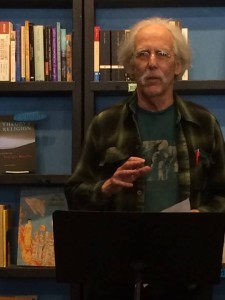 James Dorr’s career may have peaked last year when THE TEARS OF ISIS was named a Bram Stoker Award® Nominee by the Horror Writers Association for Superior Achievement in a Fiction Collection. Not to worry, it didn’t win (which undoubtedly would have gone to his head), and so he plugs on writing short stories and poems, five of the former of which can be found lurking in the archives of DAILY SCIENCE FICTION (http://dailysciencefiction.com — just search on his last name) with others in similarly nice places if perhaps less accessible. Other collections are STRANGE MISTRESSES: TALES OF WONDER AND ROMANCE and DARKER LOVES: TALES OF MYSTERY AND REGRET and his all-poetry VAMPS (A RETROSPECTIVE). An Indiana (USA) resident, Dorr also harbours a cat named Wednesday whose hobbies include playing with toy spiders.
James Dorr’s career may have peaked last year when THE TEARS OF ISIS was named a Bram Stoker Award® Nominee by the Horror Writers Association for Superior Achievement in a Fiction Collection. Not to worry, it didn’t win (which undoubtedly would have gone to his head), and so he plugs on writing short stories and poems, five of the former of which can be found lurking in the archives of DAILY SCIENCE FICTION (http://dailysciencefiction.com — just search on his last name) with others in similarly nice places if perhaps less accessible. Other collections are STRANGE MISTRESSES: TALES OF WONDER AND ROMANCE and DARKER LOVES: TALES OF MYSTERY AND REGRET and his all-poetry VAMPS (A RETROSPECTIVE). An Indiana (USA) resident, Dorr also harbours a cat named Wednesday whose hobbies include playing with toy spiders.
Blog: http://jamesdorrwriter.wordpress.com
Facebook: https://www.facebook.com/james.dorr.9
Amazon Author Page: http://www.amazon.com/James-Dorr/e/B004XWCVUS/ref=sr_tc_2_0?qid=1380306038&sr=1-2-ent
1. What was the inspiration/motivation behind your story in Blurring The Line?
I had read somewhere that the Christmas card image of happy Dickensian children spreading holiday joy from house to house singing Christmas carols fails to give the whole story. Actually the caroling urchins may have been engaging in a form of extortion, continuing to sing, loudly and badly, in front of each home until the residents gave them some money to stop. But suppose some children were more ambitious? With “The Good Work”, I asked myself what might happen if a group of Victorian children upped the anti to include deception, wholesale robbery, and murder, preyimg on the superstitions of the day.
2. What does horror mean to you?
From a reader’s point of view, not so much fear as an uneasy feeling – a feeling that something is out of kilter. Fear, if it’s there, is momentary; but the queasiness, the feeling of wrongness in what the reader has experienced should, ideally, persist. From a writer’s point of view, horror is an exercise in putting characters under stress. This can be true, too, of non-horror fiction, but in horror the stress is more intense, sometimes going to or even past the breaking point.
3. What’s a horror short story that you think everyone should read?
I’ll go with a classic, Edgar Allan Poe’s “The Tell-Tale Heart.” Here, in a sense, a character has already gone past the breaking point – the man is insane. Of course he denies it as we do too in failing to realize, as we become engrossed in the story, that the man is us.
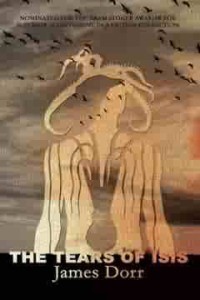 4. What horror novel should everyone read?
4. What horror novel should everyone read?
Keeping with classics, Bram Stoker’s DRACULA. This has everything, fear of the unknown, disease, mystery, even an invasion of England – opening the possibility that what we don’t know, in some cases, possibly could hurt us very much. But, interestingly, the technique used is almost the opposite of Poe’s in “The Tell-Tale Heart.” Where Poe put us right in the protagonist’s head, Stoker deliberately puts distance between us and what’s happening in the novel. We read, instead, pages from a diary, or clinical notes, or letters between people caught in the action, or even articles in a newspaper. Written documents that, if an inquiry were to be made of the story’s events afterward, are exactly the kinds of things that would be brought forth as evidence. So what might be lost in terms of immediacy – as we, with the characters, try to assemble these proofs together – results in a gain in verity, that however absurd some individual item might seem, as it’s added up with the others our feeling grows that what the conclusion will be must be true.
5. Name something that you think just might be real, or might not…
I started off as a science fiction reader and, between that and the real-life space program, by the time I was of high school age I was fascinated by UFOs. And although mostly a horror writer now, I’ve even used them in occasional stories, such as “Waxworms,” reprinted in THE TEARS OF ISIS. However I never became fully invested in the idea of government cover-ups, as plausible as such theories might have seemed given the inadequacy at times of official explanations, and, years later, as moderator on a panel on “Flying Saucers” at a science fiction convention, I found myself confronted when question time came around: Did I or did I not believe in UFOs myself? My answer was weasely, but I think true. I believe UFOs, defined as some sort of intelligently-driven spacecraft not of this Earth, could exist in principle. However, I’ve not yet been convinced of the truth of any specific example.
___________________________________
Previous posts in the Blurring The Line interview series:
Marty Young
Tom Piccirilli
Lisa Morton
Tim Lebbon
Lia Swope Mitchell
Alan Baxter
.
The post Blurring The Line: James Dorr appeared first on Alan Baxter - Warrior Scribe.
December 2, 2015
Blurring The Line: Alan Baxter
 Blurring The Line is the new anthology of horror fiction and non-fiction, edited by award-winning editor Marty Young, published by Cohesion Press. You can get your copy here or anywhere you normally buy books (the print edition is coming any day now).
Blurring The Line is the new anthology of horror fiction and non-fiction, edited by award-winning editor Marty Young, published by Cohesion Press. You can get your copy here or anywhere you normally buy books (the print edition is coming any day now).
To help people learn a bit more about it, I’ve arranged for each fiction contributor to answer the same five questions, and I’ll be running these mini interviews every weekday now that the book is available. (And yes, I have a story in it, so I’ll be interviewing myself too!)
Today, it’s me!
Alan Baxter
Yep, that’s me, being all meta and interviewing myself, as mentioned above. It seems only fair, as a contributor to this amazing book, that I answer the questions I’ve been putting to everyone else. I’ll keep the same format too, so from here on, I’ll move to third person.
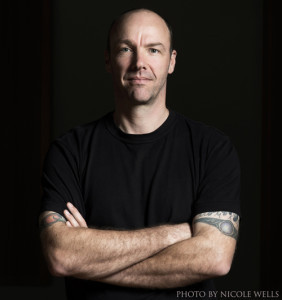 Alan Baxter is a British-Australian author who writes dark fantasy, horror and sci-fi, rides a motorcycle and loves his dog. He also teaches Kung Fu. He lives among dairy paddocks on the beautiful south coast of NSW, Australia, with his wife, son, dog and cat. He’s the award-winning author of six novels and over sixty short stories and novellas. So far. Read extracts from his novels, a novella and short stories at his website – www.warriorscribe.com – or find him on Twitter @AlanBaxter and Facebook, and feel free to tell him what you think. About anything.
Alan Baxter is a British-Australian author who writes dark fantasy, horror and sci-fi, rides a motorcycle and loves his dog. He also teaches Kung Fu. He lives among dairy paddocks on the beautiful south coast of NSW, Australia, with his wife, son, dog and cat. He’s the award-winning author of six novels and over sixty short stories and novellas. So far. Read extracts from his novels, a novella and short stories at his website – www.warriorscribe.com – or find him on Twitter @AlanBaxter and Facebook, and feel free to tell him what you think. About anything.
1. What was the inspiration/motivation behind your story in Blurring The Line?
For a long time I’ve been wanting to write a story that was in some way paying homage to that great horror novel, The Exorcist. But I also wanted to interrupt, to subvert, the strong Judeo-Christian framework of that book, and so much other western horror. I love the cosmic horror of people like Ligotti and Lovecraft, and non-western horror from Asia and elsewhere, so I tried to meld all those styles a little. “How Father Bryant Saw The Light” is the product of that desire. Hopefully I at least partly achieved what I set out to do.
2. What does horror mean to you?
Horror exposes us to darkness while at the same time providing the guiding light by which we examine that dark. Horror also shows us that sometimes there is no way out. It’s the skin peeled back to reveal the muscles and veins of life, to expose the truth more deeply than any other kind of fiction. And it helps us deal with what we find there, prepares us for the actual horror of real life.
G K Chesterton said, “Fairy tales are more than true – not because they tell us dragons exist, but because they tell us dragons can be beaten.” Horror is even more true than that, I think. Its pure honesty is the simple fact that sometimes the dragons exist and they can’t be beaten. And we need to face that.
3. What’s a horror short story that you think everyone should read?
This is such a tough one and I apologise to all the other writers for asking them! There are so many, so I’m going to pick a recent one. I’ve lately become a huge fan of everything written by Nathan Ballingrud. His collection, North American Lake Monsters, is one of the best collections I’ve ever read. So I’m going to pick one of his stories, in this case, “Skullpocket”. It was originally published in Nightmare Carnival, edited by Ellen Datlow, and you can read it for free on online, here at iO9.
4. What horror novel should everyone read?
Given what I said about my story above, I’m going to have to go with The Exorcist by William Peter Blatty. If you’ve only seen the film, you must read the book! (That actually applies to all films made from books.)
5. Name something that you think just might be real, or might not…
There’s a Japanese folkloric belief that if you can’t sleep it’s because you’re awake in someone else’s dream. That, to me, is a mind-blowing concept. On the one had it’s quite simple and demonstrably false, but just imagine if it were true…
___________________________________
Previous posts in the Blurring The Line interview series:
Marty Young
Tom Piccirilli
Lisa Morton
Tim Lebbon
Lia Swope Mitchell
.
The post Blurring The Line: Alan Baxter appeared first on Alan Baxter - Warrior Scribe.
December 1, 2015
Blurring The Line: Lia Swope Mitchell
 Blurring The Line is the new anthology of horror fiction and non-fiction, edited by award-winning editor Marty Young, published by Cohesion Press. You can get your copy here or anywhere you normally buy books (the print edition is coming any day now).
Blurring The Line is the new anthology of horror fiction and non-fiction, edited by award-winning editor Marty Young, published by Cohesion Press. You can get your copy here or anywhere you normally buy books (the print edition is coming any day now).
To help people learn a bit more about it, I’ve arranged for each fiction contributor to answer the same questions, and I’ll be running these mini interviews every weekday now that the book is available. (And yes, I have a story in it, so I’ll be interviewing myself too!)
Today, it’s:
Lia Swope Mitchell
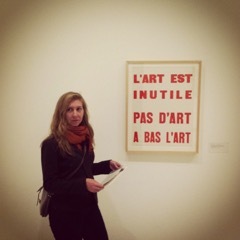 Lia Swope Mitchell is a PhD candidate in French literature at the University of Minnesota who writes fiction in moments of furtive, joyful procrastination. Her stories have appeared in Cosmos, Apex, and decomP, among other places. She teaches grammar, studies weird old books from the nineteenth century, and lives in Minneapolis.
Lia Swope Mitchell is a PhD candidate in French literature at the University of Minnesota who writes fiction in moments of furtive, joyful procrastination. Her stories have appeared in Cosmos, Apex, and decomP, among other places. She teaches grammar, studies weird old books from the nineteenth century, and lives in Minneapolis.
Find Lia at liaswopemitchell.com.
1. What was the inspiration/motivation behind your story in Blurring The Line?
My dad and his wife spend a good bit of time in New York, and a while ago they were telling me about this thing that apparently everyone learns if they ride the subway a lot: if it’s rush hour and every car on the train is packed except for one that looks totally empty… don’t get on the empty car. There’s a reason it’s empty. And the reason is probably someone who’s having one of the worse days of their life. “We can pray for him,” one woman said about an especially pungent man who was peeling the skin off his feet, “but we don’t have to smell him.”
That phrase—don’t get on the empty car—got me thinking about how people often try to close off and isolate things that disturb us. Maybe because they smell bad, but also because they’re sad and difficult and we don’t know what, if anything, we can do about them. So the story “Empty Cars” is about someone who’s trying to close off one particular thing, something difficult and sad that she wants very much to ignore, and the result is that it ends up invading her daily life in all these comically grotesque ways.
2. What does horror mean to you?
For me, horror is a lot like science fiction and fantasy in that it offers a perspective that we can’t get in everyday life, or at least not without some terrible consequences. Horror in particular is a way to explore all those weird and awful beings, ideas and fantasies, to see the world from dark and distorted angles that we would never want to experience in real life.
3. What’s a horror short story that you think everyone should read?
Well, this is a classic, but every time I read Guy de Maupassant’s “The Horla” I love it more. It’s a strange, subtle, and occasionally hilarious text that actually fits the Blurring the Line theme very well—like in Henry James’s “The Turn of the Screw,” it’s hard to say what’s really going on, whether there’s really a monster or if the narrator’s losing his mind. But there’s this gradual increase of psychological tension that just grabs on and doesn’t let go.
4. Name something that you think just might be real, or might not…
You could tell me pretty much anything about octopi and I’d believe you. I mean, they have nine brains. Of course they’re psychic. And who knows what they’re doing out in the deep ocean. They could have a whole cephalopod society down there. Are they malevolent? Not yet, but at some point I bet we’ll manage to really piss them off. I’m just glad I live in the middle of the continent.
___________________________________
Previous posts in the Blurring The Line interview series:
Marty Young
Tom Piccirilli
Lisa Morton
Tim Lebbon
.
The post Blurring The Line: Lia Swope Mitchell appeared first on Alan Baxter - Warrior Scribe.
November 30, 2015
Blurring The Line: Tim Lebbon
 Blurring The Line is the new anthology of horror fiction and non-fiction, edited by award-winning editor Marty Young, published by Cohesion Press. You can get your copy here or anywhere you normally buy books (the print edition is coming any day now).
Blurring The Line is the new anthology of horror fiction and non-fiction, edited by award-winning editor Marty Young, published by Cohesion Press. You can get your copy here or anywhere you normally buy books (the print edition is coming any day now).
To help people learn a bit more about it, I’ve arranged for each fiction contributor to answer the same five questions, and I’ll be running these mini interviews every weekday now that the book is available. (And yes, I have a story in it, so I’ll be interviewing myself too!)
Today, it’s:
Tim Lebbon
 TIM LEBBON is a New York Times-bestselling writer from South Wales. He’s had over thirty novels published to date, as well as hundreds of novellas and short stories. His latest novel is the thriller The Hunt, and other recent releases include The Silence and Alien: Out of the Shadows. He has won four British Fantasy Awards, a Bram Stoker Award, and a Scribe Award, and has been a finalist for World Fantasy, International Horror Guild and Shirley Jackson Awards. Future books include The Rage War (an Alien/Predator trilogy), and the Relics trilogy from Titan.
TIM LEBBON is a New York Times-bestselling writer from South Wales. He’s had over thirty novels published to date, as well as hundreds of novellas and short stories. His latest novel is the thriller The Hunt, and other recent releases include The Silence and Alien: Out of the Shadows. He has won four British Fantasy Awards, a Bram Stoker Award, and a Scribe Award, and has been a finalist for World Fantasy, International Horror Guild and Shirley Jackson Awards. Future books include The Rage War (an Alien/Predator trilogy), and the Relics trilogy from Titan.The movie of his story Pay the Ghost, starring Nicolas Cage, is out now, and other projects in development include Playtime (an original script with Stephen Volk), My Haunted House with Gravy Media, The Hunt, Exorcising Angels (based on a novella with Simon Clark), and a TV Series proposal of The Silence.
Find out more about Tim at his website www.timlebbon.net
1. What was the inspiration/motivation behind your story in Blurring The Line?
I’ve always wanted to write a story about spooky clowns moving in next door. And that’s it. Sometimes a story’s inspiration is something deep, a driving need to explore a certain event or feeling. For me it was just the clowns. Scary buggers.
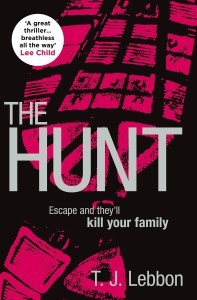 2. What does horror mean to you?
2. What does horror mean to you?
Real horror hits the head and heart, not the gut. Stuff that sets out purely to disgust or sicken isn’t really horror, although gore and nastiness can have a place in a good horror story or movie – The Thing is one of the best horror stories ever made, I think, because the bloody body horror serves to increase the intense sense of isolation and claustrophobia. The ultimate horror for me as a father is family in peril, and that’s what I write about a lot of the time, to a greater or lesser degree.
3. What’s a horror short story that you think everyone should read?
“The Whimper of Whipped Dogs” by Harlan Ellison. Shocked and upset me the first time I read it, and it still does now.
4. What horror novel should everyone read?
The Road by Cormac McCarthy. Truly painful and disturbing to read, and the movie was also excellent.
5. Name something that you think just might be real, or might not…
Ghosts. I’ve seen no evidence, though I have an open mind. I think if they can be said to exist, ghosts are probably products of the mind – aspects we haven’t been able to pin down scientifically yet – rather than revenants of the dead.
___________________________________
Previous posts in the Blurring The Line interview series:
Marty Young
Tom Piccirilli
Lisa Morton
.
The post Blurring The Line: Tim Lebbon appeared first on Alan Baxter - Warrior Scribe.
November 29, 2015
Blurring The Line: Lisa Morton
 Blurring The Line is the new anthology of horror fiction and non-fiction, edited by award-winning editor Marty Young, published by Cohesion Press. You can get your copy here or anywhere you normally buy books (the print edition is coming any day now).
Blurring The Line is the new anthology of horror fiction and non-fiction, edited by award-winning editor Marty Young, published by Cohesion Press. You can get your copy here or anywhere you normally buy books (the print edition is coming any day now).
To help people learn a bit more about it, I’ve arranged for each fiction contributor to answer the same five questions, and I’ll be running these mini interviews every weekday now that the book is available. (And yes, I have a story in it, so I’ll be interviewing myself too!)
Today, it’s:
Lisa Morton
 Lisa Morton is a screenwriter, author of non-fiction books, award-winning prose writer, and Halloween expert whose work was described by the American Library Association’s Readers’ Advisory Guide to Horror as “consistently dark, unsettling, and frightening”. Her most recent releases include Ghosts: A Haunted History and the short story collection Cemetery Dance Select: Lisa Morton. She currently serves as President of the Horror Writers Association, and can be found online at http://www.lisamorton.com .
Lisa Morton is a screenwriter, author of non-fiction books, award-winning prose writer, and Halloween expert whose work was described by the American Library Association’s Readers’ Advisory Guide to Horror as “consistently dark, unsettling, and frightening”. Her most recent releases include Ghosts: A Haunted History and the short story collection Cemetery Dance Select: Lisa Morton. She currently serves as President of the Horror Writers Association, and can be found online at http://www.lisamorton.com .
1. What was the inspiration/motivation behind your story in Blurring The Line?
I work in a used bookstore (the Iliad Bookshop in North Hollywood, California) and some time ago we acquired a remarkably strange volume: a nineteenth-century home-made scrapbook called SWEET DEATH. The owner, whoever s/he was, had pasted hundreds of newspaper clippings into the pages of an old math textbook; the clippings ran the gamut from ghost stories to true crime tales to just oddball bits. I was really knocked out by a story that fell into the latter category, about two teenage girls who tried to escape their abusive families by dressing as men and fleeing on the train. The story was horrifying and melancholy and strange all at once, and I had to write about it.
2. What does horror mean to you?
Any work of art in which the primary intent is to horrify or disturb. My personal favorites are those works that you find yourself still thinking about days later, maybe with a little mental shiver.
3. What’s a horror short story that you think everyone should read?
Anything by Dennis Etchison. He’s the world’s most under-recognized horror author. There are stories by him I’m still thinking about thirty years after first reading them. It’s just criminal that he’s not much recognized outside of a small circle of horror readers.
4. What horror novel should everyone read?
Bram Stoker’s DRACULA. It’s the great grand-daddy of all modern horror novels, and it’s still a damned fine read.
5. Name something that you think just might be real, or might not…
Ghosts. Having just finished writing a big nonfiction history of them, I’m still not convinced that we’re haunted by spirits of the dead, but it would be downright silly to deny that SOMETHING’s going on. I tend to think the answer might be neurological – that certain people are wired to take stimuli, like ultralow frequency sound waves, and convert that into hallucinations of humanoid figures. Or it could be something completely different…
_________________________________
Previous posts in the Blurring The Line interview series:
Marty Young
Tom Piccirilli
.
The post Blurring The Line: Lisa Morton appeared first on Alan Baxter - Warrior Scribe.

